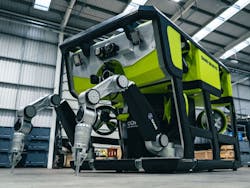Saipem and TechnipFMC have entered a global commercial agreement to identify subsea opportunities worldwide that they could jointly execute. They are targeting subsea umbilicals, risers, and flowlines (SURF) projects where the companies’ complementary assets, technologies, products, installation methods, and competencies could improve project economics and de-risk the overall project development.
One goal is to provide greater operational flexibility and optimized delivery under TechnipFMC’s iEPCI (integrated engineering, procurement, construction and installation) and EPCI project execution models.
Jonathan Landes, president, Subsea at TechnipFMC, said: “The strengthened offering will also expand the potential market for iEPCI opportunities when combined with TechnipFMC’s innovative Subsea 2.0 production systems.”
Stefano Porcari, COO of Saipem’s E&C Offshore Division, added: “The agreement will provide a pool of complementary enabling vessels and facilities and a consolidated reel laying and J-laying technology base. Together we will be able to provide a full service for those challenging developments requiring an ample range of technologies and capabilities.”
Recently, both companies won contracts offshore South America.
ExxonMobil has contracted TechnipFMC to supply the subsea production system for the Yellowtail development offshore Guyana. Subject to government approvals and final project sanction, the company will provide project management, engineering, manufacturing, and testing capabilities for 51 enhanced vertical deepwater trees and associated tooling, as well as 12 manifolds and associated controls and tie-in equipment.
This is the company’s fourth award from ExxonMobil in the Stabroek block.
Petrobras has awarded Saipem a $940-million SURF EPCI contract for the Búzios 7 project in the presalt Santos basin offshore Brazil. The company will supply and install a rigid steel lazy-wave riser-based subsea system for the development, 200 km (124 mi) offshore Rio de Janeiro state in a water depth of 2,000 m (6,562 ft). The full scope includes the associated flowlines interconnecting 15 subsea wells to the FPSO and related service lines and control umbilicals.
In addition, Saipem will provide and install the FPSO anchors and manage hookup of the platform at the field location. The company will deploy its field development ship FDS to install the risers.
Finally, Saipem and WSense have agreed to jointly develop communication networks for subsea drones. The partnership will design multi-purpose intelligent nodes to interface with underwater drones engineered and operated by Saipem subsidiary Sonsub. Goals include advancing wireless interconnection of underwater equipment and sensors and the integration of diverse systems and technologies.
Saipem expects its resident subsea drones and ROVs to benefit through being able to autonomously perform complex tasks requiring the exchange of data for positioning and supervising subsea infrastructure, leading to creation of an underwater Internet of Things.
Ocean Infinity, Argeo order subsea robots
Argeo, a subsea data acquisition and visualization survey specialist, has ordered an autonomous ‘snake robot’ from Eelume. This is the first commercial contract award for the technology, which Eelume has developed with support from Kongsberg Maritime.
In operation, one Eelume robot is said to provide a serviceable footprint of 50-75 sq km (19-29 sq mi). Argeo plans to deploy the technology with its unmanned surface vessels for autonomous subsea inspections. The Norwegian company has developed sensors and analytical tools that can be integrated with robotics platforms such as the Eelume.
CEO Trond Crantz said: “In addition to lowering carbon footprint and increasing efficiency, Eelume technology will enable Argeo to significantly reduce the costs related to inspection, light intervention and monitoring of subsea assets and infrastructure. Currently, 90% of these costs are vessel-related. Implementing Eelume as a resident inspection tool for offshore wind and oil and gas will replace up to 70% of vessel activities.”
Ocean Infinity has ordered 10 electric work remotely operated vehicles (eWROV) from Saab Seaeye.
The eWROV is the latest addition to Saab Seaeye’s underwater portfolio. It is the culmination of four years of research and development, resulting in a larger and more powerful ROV compared to those designed for light work and observation tasks, the company claimed.
The all-electric, work-class underwater robots will be built in the company’s new facility in Fareham, UK. The company said its intelligent control of nodes system architecture makes the eWROV capable of fully autonomous operation.
According to Saab Seaeye, it is among the first companies to produce a full-size electric work-class vehicle that can deliver the same overall performance as a 250 horsepower hydraulic vehicle, while offering a lower lifetime cost and reduced environmental impact.
Magnus Lewis-Olsson, chairman of Saab UK, said: “Ocean Infinity’s order is the largest in Saab Seaeye’s history and highlights the need for intelligent, adaptable, and flexible underwater robotics. The eWROV is more efficient and cleaner than the hydraulic alternatives and it also requires less human involvement and will play an important role in future autonomous vessel fleets.”
Ocean Infinity is developing the world’s largest fleet of uncrewed robotic vessels.
About the Author
Jessica Stump
Editor
Jessica Stump is editor of Offshore Magazine. She uploads and writes news to the website, assembles surveys and electronic newsletters, and writes and edits articles for the magazine. She was the summer editorial intern at Offshore in 2009 and 2010 before joining full time in April 2011. She has a journalism degree from Texas Tech University.

